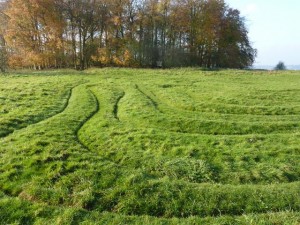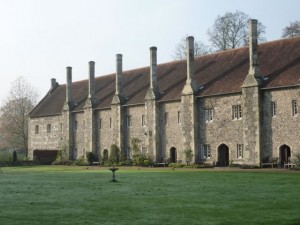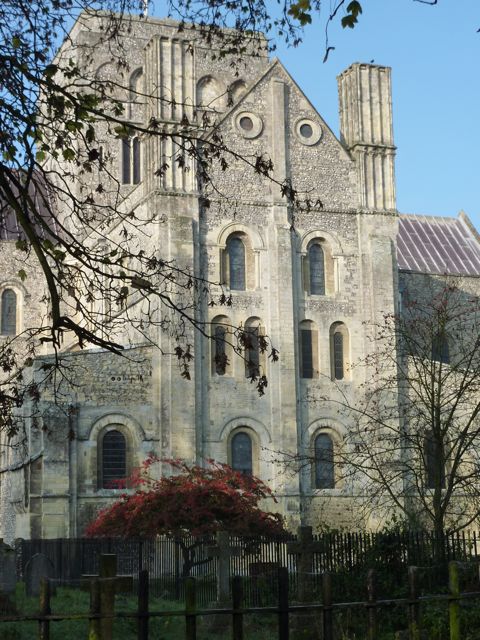
The top of the hill was an Iron Age fort. Stand there and look around. The beech woods slide down the earthworks and delve you down into the valley of the river Itchen. Tributaries of chalk streams of the tickled brown trout and some of the best fly-fishing in England. Behind the hill the traffic snorts heavily and with deep petrol shout. The M3 carves through chalk escarpment and hurries BMWs and caravans west to Southampton and beyond. But once you have the high beech trees between you and the sky, it is calm and contemplative. Here I would sling my hammock, or better still pitch my tipi.
In front of it and on a flatish bit of hilltop land a mismaze called Labyrinth is carved in the ground. It is a puzzling puzzle. For ritual? For amusement? No-one seems certain how or why this low but thrilling early piece of land art is here. Facts are woolly: it’s said to be copied from flooring in Chartres cathedral, no older than the 17th century. To be traced round and round like a maze: the perfect unravelling skein for a walking meditation.

The city of Winchester unfolds below. Very ladylike and easy on the eye. The Cathedral is pretty spectacular as a piece of Norman architecture. The tower collapsed centuries ago and it lies long and supine. The architectural eyecatcher is St Cross. Founded by Henry de Blois, Bishop of Winchester, in the mid twelth century. It provides the accommodation of almshouses and is the oldest charitable institution in the country. Pilgrims passing, en route to Canterbury, can still demand Wayfairers Dole - a piece of bread washed down with a mug of beer.
[caption id="attachment_1461" align="aligncenter" width="480" caption="the Norman church"]

[/caption]
Men over the age of 60 can retire here. I think this is pretty unfair as I would be more than happy to don the gown and spend one hour every day in the church, a soaring wonder of the heights of Norman architecture. Built around 1140 this building is nearly 900 years old. There are older buildings but this one makes me go weak at the knees.
 The top of the hill was an Iron Age fort. Stand there and look around. The beech woods slide down the earthworks and delve you down into the valley of the river Itchen. Tributaries of chalk streams of the tickled brown trout and some of the best fly-fishing in England. Behind the hill the traffic snorts heavily and with deep petrol shout. The M3 carves through chalk escarpment and hurries BMWs and caravans west to Southampton and beyond. But once you have the high beech trees between you and the sky, it is calm and contemplative. Here I would sling my hammock, or better still pitch my tipi.
In front of it and on a flatish bit of hilltop land a mismaze called Labyrinth is carved in the ground. It is a puzzling puzzle. For ritual? For amusement? No-one seems certain how or why this low but thrilling early piece of land art is here. Facts are woolly: it’s said to be copied from flooring in Chartres cathedral, no older than the 17th century. To be traced round and round like a maze: the perfect unravelling skein for a walking meditation.
The top of the hill was an Iron Age fort. Stand there and look around. The beech woods slide down the earthworks and delve you down into the valley of the river Itchen. Tributaries of chalk streams of the tickled brown trout and some of the best fly-fishing in England. Behind the hill the traffic snorts heavily and with deep petrol shout. The M3 carves through chalk escarpment and hurries BMWs and caravans west to Southampton and beyond. But once you have the high beech trees between you and the sky, it is calm and contemplative. Here I would sling my hammock, or better still pitch my tipi.
In front of it and on a flatish bit of hilltop land a mismaze called Labyrinth is carved in the ground. It is a puzzling puzzle. For ritual? For amusement? No-one seems certain how or why this low but thrilling early piece of land art is here. Facts are woolly: it’s said to be copied from flooring in Chartres cathedral, no older than the 17th century. To be traced round and round like a maze: the perfect unravelling skein for a walking meditation.
 The city of Winchester unfolds below. Very ladylike and easy on the eye. The Cathedral is pretty spectacular as a piece of Norman architecture. The tower collapsed centuries ago and it lies long and supine. The architectural eyecatcher is St Cross. Founded by Henry de Blois, Bishop of Winchester, in the mid twelth century. It provides the accommodation of almshouses and is the oldest charitable institution in the country. Pilgrims passing, en route to Canterbury, can still demand Wayfairers Dole - a piece of bread washed down with a mug of beer.
[caption id="attachment_1461" align="aligncenter" width="480" caption="the Norman church"]
The city of Winchester unfolds below. Very ladylike and easy on the eye. The Cathedral is pretty spectacular as a piece of Norman architecture. The tower collapsed centuries ago and it lies long and supine. The architectural eyecatcher is St Cross. Founded by Henry de Blois, Bishop of Winchester, in the mid twelth century. It provides the accommodation of almshouses and is the oldest charitable institution in the country. Pilgrims passing, en route to Canterbury, can still demand Wayfairers Dole - a piece of bread washed down with a mug of beer.
[caption id="attachment_1461" align="aligncenter" width="480" caption="the Norman church"] [/caption]
Men over the age of 60 can retire here. I think this is pretty unfair as I would be more than happy to don the gown and spend one hour every day in the church, a soaring wonder of the heights of Norman architecture. Built around 1140 this building is nearly 900 years old. There are older buildings but this one makes me go weak at the knees.
[/caption]
Men over the age of 60 can retire here. I think this is pretty unfair as I would be more than happy to don the gown and spend one hour every day in the church, a soaring wonder of the heights of Norman architecture. Built around 1140 this building is nearly 900 years old. There are older buildings but this one makes me go weak at the knees. 